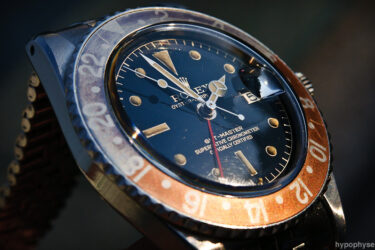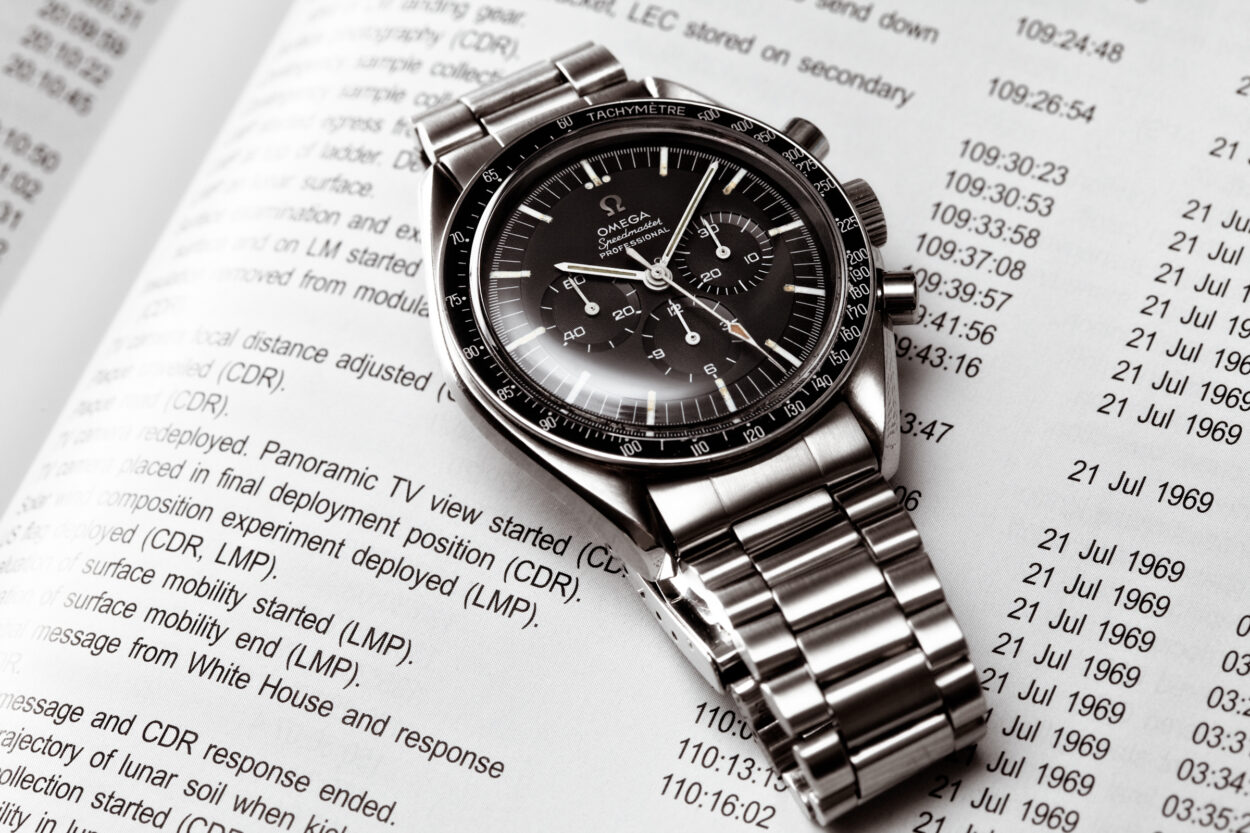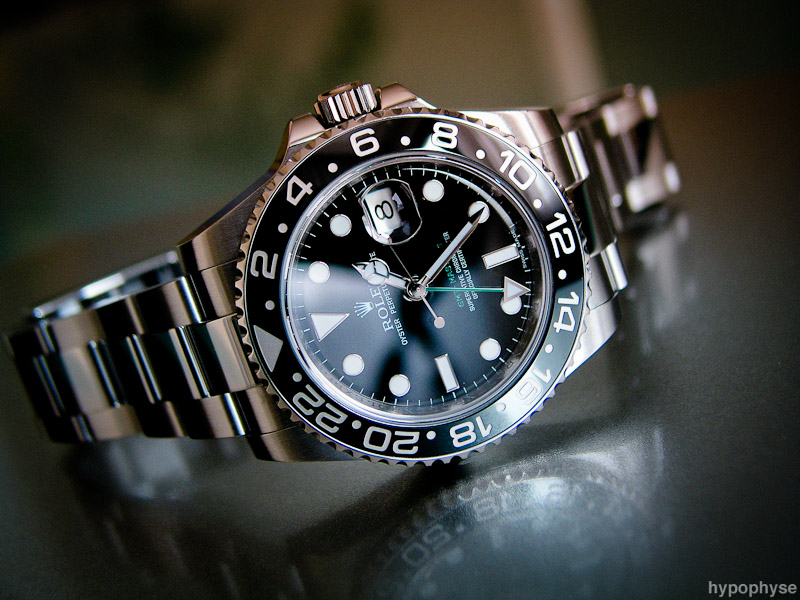Despite being endlessly fascinating, the world of Rolex is filled with jargon that you need to know to appear as though you speak Rolex.
For many, it takes time to learn this jargonistic dictionary largely invented by us collectors.
But we’ve collated what we believe are the key ingredients required to appear like a Rolex expert. So, prepare your notepads, here is Rolex Jargon Unlocked.
Rolex General Terminology
We’ve broken this down into two main categories, general terminology and then nicknames.
To have a basic understanding of Rolex watches we have alphabetised the following which are useful. They will provide you with a base for any conversation.
- Aluminium Bezel – the aluminium bezel was produced by Rolex, predating the Cerachrom bezel that modern bezel watches currently have.
- Baton Markers – also known as baton indexes, which are rectangular in shape, these are found on Tool or Sports watches, and, notably, some Datejusts.
- Bubble-back – a beautiful selection of watches dating from the early 1930s to the mid-1950s and feature a rounded and ballooned case-back.
- COMEX (Compagnie maritime d’expertises) – the French diving company that partnered with Rolex during the 1970s to produce some exclusive dive watches. For a comprehensive breakdown click here.
- COSC (Contrôle Officiel Suisse des Chronomètres) – the institute that regulates the accuracy and precision of Swiss watches.
- Cerachrom Bezel – Rolex patented in 2005 a bezel which combined ceramic and ‘chrom’ (colour) which they use on their professional models.
- Crown Guards – the form of protection which surrounds the crown on the side of the watch to prevent it from unscrewing during professional activities.
- Cyclops – a small bubble on the crystal of the watch which magnifies the date.
- Easy link – Rolex’s patented design on the clasp of the bracelet allows the wearer to extend the bracelet by 5mm and do so without any tools.
- Everose – Rolex’s term for rose gold, presented in 2005 and which is on Rolex Oyster models.
- Fluted Bezel – this type of bezel is found on Oyster Perpetuals, Datejusts and Day-Dates and was released in 1926, originally designed to aid in waterproofing the case.
- Gilt – this term is used to describe Rolex dials. This was the first type of dial used by Rolex. They can be identified by the gold text and gold markings.
- Gloss Dial – until the 1980s Rolex used matte dials, before replacing them with gloss dials. Modern sports watches can be seen with glossy dials and are certainly the most common out there.
- Helium Escape Valve (HEV) – we mentioned COMEX earlier. Well, this was one of the developments during this period… what is it? Find out here.
- Jubilee Bracelet – the jubilee bracelet is found on sports and professional models; and uses a five-piece, semi-circular link design.
- Matte Dial – in the mid-late 1960s Rolex introduced matte dials. They have a grey/black surface finish and tritium hour markers.
- Maxi Dial – a dial configuration where there are larger markers as well as minute and hour hands. They are standardised for modern sports watches except for the Daytona.
- Mercedes Hands – the term used to describe the hour hand which boasts a Mercedes-style logo towards the tip of the hand.
- Meters-first – the rare dial configurations when meters come before feet for the depth rating on the dial. This marks a time when Rolex transitioned from gilt dials on the 5513 to matte dials in 1966.
- Mother of Pearl – a dial configuration used mostly on ladies’ watches which gives the appearance of a pearl.
- Nipple Dial – a dial configuration where the hour markers are ever so slightly protruding and are exclusively produced in yellow gold. They can be found on vintage GMT-Master’s or Submariners.
- No Date – this term is famously used to describe any Submariner model which doesn’t possess a date window.
- (No) Holes Case – this term is used to determine whether the lugs have holes or not. These holes are used to release the spring bar and therefore remove the bracelet.
- Onyx Dial – a very rare dial that is recognisable for its absence of hour markers. There are many variations of the Onyx dial but are almost always found on Datejusts or Day-Dates.
- Oyster Bracelet – the classic bracelet used on Rolex watches from the 1930s onwards. It has three links, unlike the 5-link jubilee.
- Panda – this is another dial configuration which highlights the contrast between black and white.
- President Bracelet – the president bracelet is a semi-circular, three-link bracelet seen on the Day-Date (or the president) line of watches.
- Radium – Rolex used radium as their luminescent material until 1963. This material has been proven to be radioactive.
- Sigma Dial – a true enigma, it’s a fascinating story! Find out more here.
- Spider Dial – this term is used to describe dials produced during the transition between matte and gloss, some of the dials cracked due to poorly applied lacquer.
- Super-luminova – the luminescent material used by Rolex. This material was first used in 2000 and replaced luminova.
- Tritium – Tritium followed Radium as Rolex’s luminescent material. However, much like radium, it is also radioactive.
- Tropical Dial – a type of dial (often patinated) that has a faded tone. This is usually caused by direct sunlight.
- Underline Dial – the final dial variation of the list. This seemingly insignificant marking on the dial can be found above or below the hands. They were produced for a very small period of time, potentially from 1962 to 1964. It is believed that it signifies the transition of radioactive material, radium to tritium. Although nobody knows exactly. Watches with an underline dial fetch a premium on the vintage market.
Rolex Nickname Terminology
You often hear Rolex nicknames, here are the most common:
- Batgirl – the blue and black bezel GMT-Master II on a Jubilee bracelet.
- Batman – the blue and black bezel GMT-Master II on an Oyster bracelet.
- Coke – the GMT Master with a red and black bezel.
- Double Red – the Seadweller produced between 1967 and 1977, with two lines of red text on the dial.
- Fat Lady – the nickname for the 16760 GMT-Master II which leveraged the calibre 3085 movement, making it thicker than its predecessors.
- Great White – the Seadweller ref. 1665 produced between 1977 and 1983, was named just that due to the all-white text on the dial.
- Hulk – the Submariner date, reference 116610LV, with a green dial and bezel.
- Mil-Sub – Submariners which have fully-graduated bezels and a T on the dials. They are references 5513 and 5517.
- Kermit – the anniversary edition of the Submariner date, released in 2003 with a green bezel and black dial.
- Patrizzi – this is yet another variation to the dial. More specifically this nickname is used for the Zenith Daytona, or the 16520. The counters have been patinated on these dials to a warm toasted colour (often brown).
- Paul Newman – the most expensive wristwatch ever sold. It was worn by the movie star, Paul Newman. If you want to learn more about the reference 6239 or the other Paul Newmans, we wrote a guide to these highly sought-after pieces.
- Pepsi – this refers to the GMT-Master (II) which has a red and blue bi-rotational bezel.
- Polar – a white dial Explorer II.
- Smurf – a white gold Rolex Submariner, 116619LB.
- Steve McQueen – the Rolex Submariner 5513 worn by the actor himself.
- Thunderbird – the Rolex Datejust Turn-o-Graph which was worn by a thunderbird pilot.
Where to go now?
If you really do want to master these terms it’ll take a bit of practice. Perhaps you’ll only learn a few off by heart to drop into conversation.
Regardless of how you will use these terms, you are now equipped with the most crucial jargon words to make you sound more like a Rolex expert.
(Featured Image Reference: “Rolex GMT-Master 1675 PCG” by hypo.physe is licensed under CC BY-SA 2.0.)




